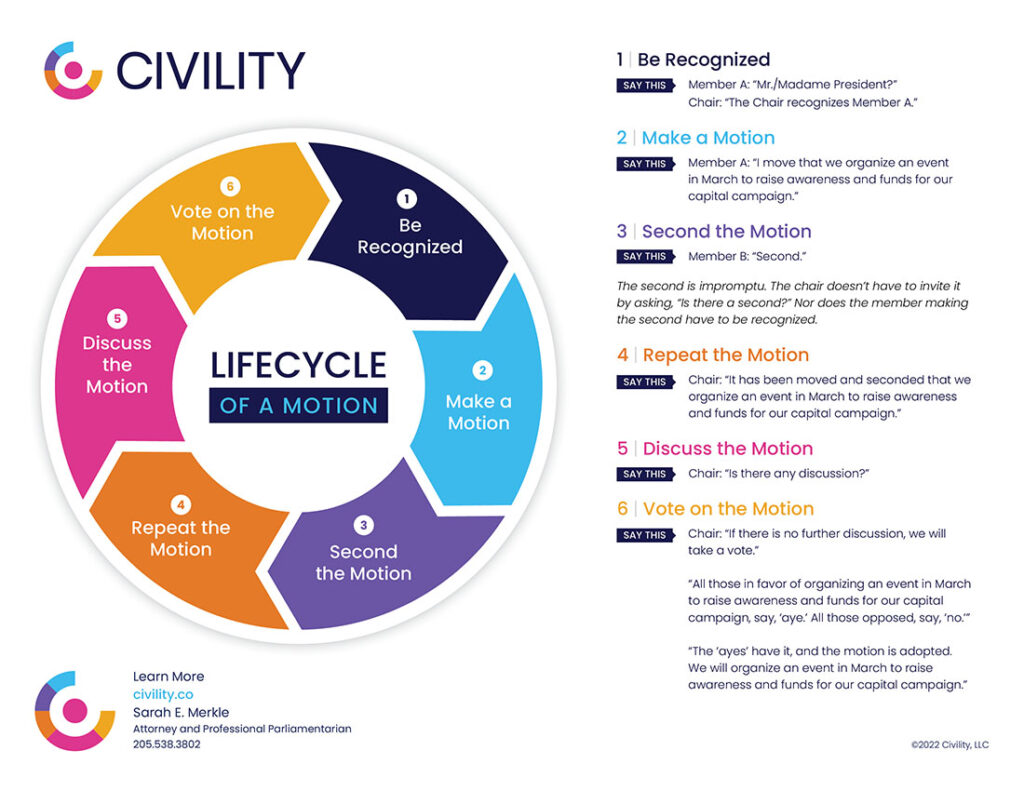In the world of parliamentary procedure, there are main motions, and then there are “non-main” motions. In the category of “non-main” motions, also called secondary motions, are motions to Table, Close Debate, Refer to Committee, and Amend. Have you ever wondered how those secondary motions work together with main motions? Today’s post provides an introduction.
1. What is the difference between a main motion and a secondary motion?
A main motion is a substantive proposal that a group take specific action. It starts with the words, “I move that” and continues with your very best thought about what you think the group should do.
Here’s an example of a main motion: “I move that the Board of Directors meet once a month on Saturday mornings at 7:00 a.m.”
Once a main motion is proposed, its merits are discussed, and then the group votes. After the vote on one main motion, another main motion can be proposed.
The motion-making process always follows the same six steps.
A secondary motion focuses on procedure and process rather than on substance. As far as timing, secondary motions are often made while a group is discussing a main motion, but not always.
Here are two examples of secondary motions: “I move that we refer the main motion to the Governance Committee.” Or, “I move that we close debate on the motion currently on the floor.”
2. How do secondary motions work together with main motions?
The key fact to remember about handling both main motions and secondary motions is that secondary motions suspend consideration of main motions. In other words, if a secondary motion is made while a main motion is on the floor, the secondary motion takes priority over the main motion in the sense that it must be dealt with and voted on before a vote is taken on the main motion.
Here are three examples, all using the main motion example above.
Secondary Motion Example 1: Motion to Amend
Member A thinks that meeting at 7:00 a.m. isn’t early enough for a Saturday morning and moves to amend the main motion by striking 7:00 a.m. and inserting 6:00 a.m.
In this case, the motion to Amend takes priority over the main motion, and the group should pause to discuss the merits of 7:00 a.m. versus 6:00 a.m., vote on whether to replace 7:00 a.m. with 6:00 a.m., and then go back to discussing the main motion—as amended if the motion to Amend passes, or as originally stated if the amendment fails.
Secondary Motion Example 2: Motion to Refer to Committee
Member B thinks that how often the Board meets and when should be researched a bit, so she moves to refer the motion to the Governance Committee with instructions to report back with recommendations at the next members meeting.
The motion to Refer takes priority over the main motion, and the group should pause to discuss the merits of referring the main motion to the Governance Committee and take a vote on whether to do so. If the motion to Refer is adopted, the group should refer the main motion to the Governance Committee, and the floor would then be open for the next main motion. If the motion to Refer is defeated, the group may continue discussing the merits of having board meetings once a month on Saturdays at 7:00 a.m.
Secondary Motion Example 3: Motion to Close Debate
Member C thinks that debate on the main motion has gone on too long and wants to move to another topic, so he says, “I call the question.”
The motion to Close Debate—also known as “moving the previous question” and signaled by a member saying, “Question” or “I call the question”—takes priority over the main motion, and the group should pause discussion and vote on whether to close debate. This secondary motion is not itself debatable, and in order to pass, it needs two-thirds of those voting to be in favor of its adoption. If the motion to Close Debate is adopted, the group should vote immediately on the main motion. If the motion to Close Debate is defeated, the group should go back to discussing the merits of the main motion.
In sum, being able to recognize secondary motions and understand how they work together with main motions is critical for using parliamentary procedure to increase the efficiency of a meeting. Main motions and secondary motions are both useful tools that work together in enabling an organization to get things done. Don’t be afraid of allowing a secondary motion to suspend discussion of a main motion! Those “non-main” motions may actually provide clarification, help wrap up long-winded debate, or allow a committee to discuss an issue more thoroughly at a separate time.
Where to Learn More


